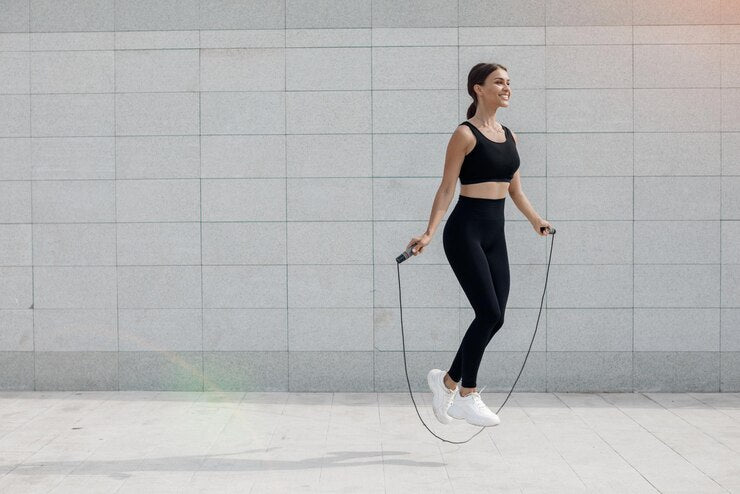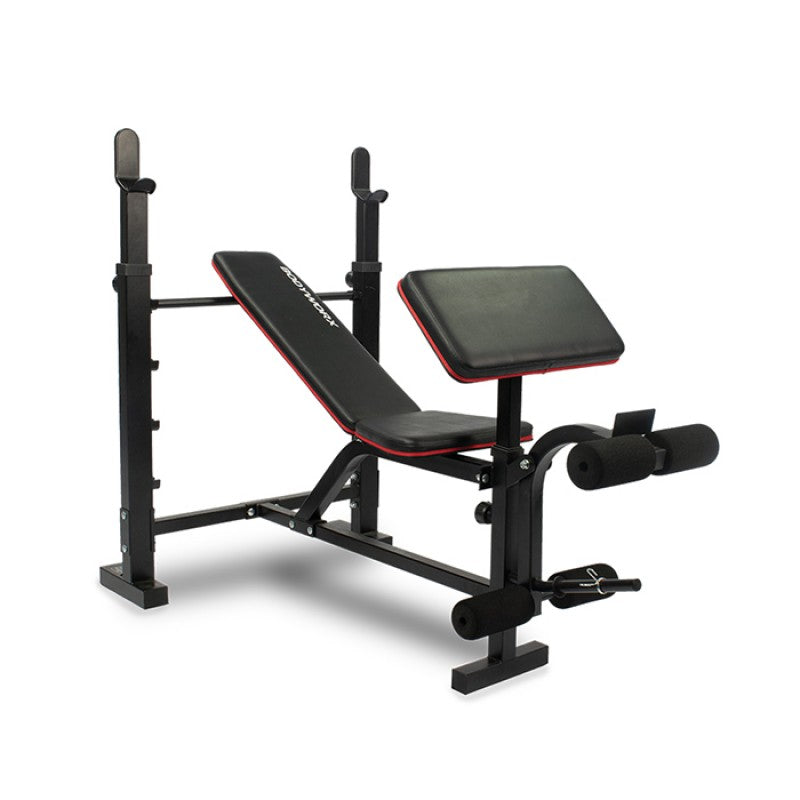
Step into the world of jump ropes, where fitness meets fun!
Remember the thwack, thwack, thwack of childhood?
Well, it’s not just nostalgia. It’s your entry to an affordable and power-packed workout. In just 7 to 10 minutes, you’ll sculpt your lower body and be done with your cardio.
And the best part?
You can toss that rope into your suitcase when travelling, and make sure you never miss a workout. All you need is a jump rope and a bit of space. No fancy gear or endless gym hours.
Ready to redefine your jump rope for fitness game? We’ve got you covered.
Let’s jump in!
What Is Jumping Rope Good For?
So, what’s the deal with jumping rope?
Jumping rope is a full-body workout. This exercise isn’t just a heart-pumper. It’s a speed booster too.
Why?
Because as you bounce on your toes. You activate those fast-twitch muscles. This levels up your speed game.
10 Health Benefits of Jumping Rope

1. Burns calories & Shrinks Belly Fat
Jumping rope stands as an effective calorie-burning exercise. It eliminates 200-300 calories in just 15 minutes. A top choice for cardio workouts.
The exercise engages major muscle groups. Creating a thermogenic effect that increases calorie burn and promotes weight loss.
2. Improves Stamina
Jumping rope goes beyond burning calories. It’s a great friend in making you stronger. The Centers for Disease Control and Prevention (CDC) recognizes its power.
It mixes jump rope for fitness, focus, and footwork, making you tougher.
If you want a quick way to boost your stamina and keep your heart happy. Do 10 to 15 minutes of jump rope for heart.
3. Improves Quickness & Coordination
Jumping rope is a super tool for staying balanced. When you jump.rope. You need to focus and find a rhythm. This makes your body better at important things like being coordinated and quick.
Jumping rope makes your whole body work together. Hence, improving how your eyes, feet, and hands coordinate.
4. Builds bone density
Jumping rope acts as a guardian for your bones. With age, bone density decreases, leading to conditions like osteoporosis. However, engaging in high-impact exercises like jumping rope can cancel out these effects.
As evidenced by a 2015 study focusing on premenopausal women. Regular jumping sessions, even just 10 or 20 jumps with short breaks, led to improved hip bone density over 16 weeks.
While recognizing these bone-strengthening jump rope benefits. It’s crucial to consult with your doctor. Especially if osteoporosis is a concern.
5. Builds Power & Tone Muscles
Jumping rope engages various muscle groups. This makes it a full power-building exercise. The main muscles worked include the calves, quads, hamstrings, core, shoulders, and biceps.
Jumping rope requires total body action and contributes to the sculpting of various muscle groups all together.
6. Develops Balance
Jumping rope is a helpful tool for building balance. Research shows that the repetitive and cyclic nature of jumping rope needs constant balance. This makes it an important addition to balance-focused exercises.
Various jump rope drills, such as one-legged jumps, side-to-side movements, or high knees, contribute to improved balance and motor coordination.
These exercises challenge your body to re-establish balance between each jump.
7. Create Stronger Heart
Jumping rope not only raises your heart rate but also stimulates active blood circulation.
Jumping rope increases oxygen delivery to muscles. This helps in lowering cholesterol. The increased blood flow helps to maintain healthy blood pressure levels.
Create a jump rope for fitness routine. As it offers dual benefits of heart workout and cholesterol control.
8. Lowers Injury Risk
Jumping rope plays a key role in decreasing the risk of injuries during both exercise sessions and daily activities. This exercise creates agility, improving overall body awareness and coordination.
As you participate in consistent jump rope workouts. Your body becomes more agile which reduces the chances of injuries.
The improved coordination between upper and lower body movements creates a more injury-resistant physique.
9. Reduces stress
Research from 2021 highlights the stress-reducing jump rope benefits. Exercise, including jumping rope, imitates the effects of stress on the body. This allows the body to practice and work through stress responses. Ultimately protecting against harmful effects in the future.
Beyond the physiological response, jumping rope allows individuals to momentarily forget daily stresses. Hence, providing a mental reset.
10. Make Lungs Strong
Jumping rope exercises also benefit the lungs. Improved blood circulation and controlled breathing patterns contribute to respiratory health.
Jumping rope, with its rhythmic breathing, helps as a practical means to increase lung function. Creating stronger and healthier lungs.
If you want to boost your breathing health, jumping rope offers a simple yet effective solution.
BONUS Benefits of Jumping Rope
- Jumping rope offers active meditation, promoting calm and focus.
- Combining it diversifies workouts, enhancing weight loss and muscle gain.
- It serves as an easy travel companion workout tool for travel-friendly exercise.
- A 5 to 10-minute jump rope warmup prepares you for intense physical activities.
- Beyond cardio, it engages muscles from head to toe, providing a full-body workout.
- It’s a quick, time–efficient cardio option. With 30 seconds equivalent to 2X moderate-intensity activities (CDC).

Jump Rope Basics and Best Form Tips
How Can Beginners Start Jumping Rope?
Starting to jump rope is easy for beginners. All you need is a properly sized rope, a suitable surface, comfortable clothes, and a bit of know-how on proper form.
Start with the following basics for a smooth beginning to your jumping rope journey.
How to Select Right Size Jump Rope | 3 Tips
Selecting the right jump rope is necessary for keeping the best form and reducing injury. Let’s break it down:
- Measure the Rope: Stand on the middle of the rope with one foot and raise the handles to reach your armpits or shoulders. Choose a rope that allows for easy adjustment based on your height.
- Start with Light Rope: Start with a light jump rope. Once you’ve mastered the basics, experiment with weighted options to intensify your workout.
- Adjust Length: If the rope is snagging on your shoes, opt for a longer one. If it feels like it’s dragging on the floor, go for a shorter length.
A Simple Rule: Get the ideal rope length by adding 3.5 feet to your height.
How To Jump Rope
Now coming to the process and technique of jumping rope.
- Hold the ends of your jump rope in each hand.
- The loop will be resting on the ground behind your heels. This is your starting position.
- Swing the rope forward over your head. As it glides under your feet, give it a jump.
- Keep the momentum going. Repeat the motion.
Best Form For Jumping Rope
- Maintain Form: Keep your chest up and core engaged. Let shoulders and elbows take a backseat. Maintain a straight-ahead gaze.
- Bend Knee, Close Arms: Bend your knees slightly and keep your upper arms close to your ribs during jumps.
- Wrist Focus: Put the focus on wrist movement. Reduce elbow and shoulder motion.
- Shock Absorption Landing: Land on the balls of your feet with slightly bent knees to absorb landing shock.
How to Use Jump Rope For Weight Loss
Jumping rope works all your muscles. Ultimately, burning more calories for weight loss.
As a beginner, start with a low-intensity jumping rope. Gradually gain control and coordination. Change intensity over time.
For effective weight loss with jumping rope:
- Target Whole Body Fat: Jumping rope reduces overall body fat.
- Useful Intensity: Singles at your preferred intensity.
- Inexpensive Workout: A cheap, equipment-free exercise.
- Combine with Balanced Diet: Increase weight loss with a proper diet.
Celebrities like Jennifer Garner, Justin Bieber, Kate Hudson, Kim Kardashian, Kayley Cuoco, and Nick Connelly endorse jumping rope for a transformative workout.
Precautions For Jumping Rope
- Warm-up: Focus on a 10-minute warm-up to prepare your muscles.
- Hydrate: Stay hydrated by drinking electrolyte water before and after the session.
- Wear Sports Bra: For added comfort and support, consider wearing a sports bra.
- Shock-absorbing Socks: Wear shock-absorbing socks to minimize the risk of injury.
How to Avoid Injuries When Jumping Rope
Jumping rope is a fantastic workout for weight loss. But avoiding injuries is crucial. Follow these tips for joint safety:
A. Know Injury Signs
Know the difference between normal pain and injury-associated pain.
Muscle soreness improves with time and stretching. While injuries cause constant pain, swelling, and fatigue.
B. Jump on Right Surface
Avoid hard surfaces like asphalt and concrete for rope jumping.
Opt for shock-absorbing surfaces like wooden or rubber flooring to reduce injury risks. Or buy a jump rope mat.
C. Wear Proper Shoes
Invest in quality shoes with active shock absorption for comfort and injury prevention.
D. Control How Much You Jump
Beginners should avoid excessive jumping to prevent stress-related injuries.
Ensure adequate rest and recovery. Changing workout intensity and duration.
E. Never Skip Warm-up
Increase blood flow and heart rate gradually with a warm-up before starting your jumping routine.
F. Always Stretch
Don’t skip stretching. It’s crucial for preventing muscle tightness.
Include a 30-to-60-second stretching session on rest days. End your workouts with a few simple yoga stretches.
Do You Need A Weighted Jump Rope?
When choosing a jump rope. You will encounter weighted options. Getting the right jump rope is important. Especially for beginners aiming to introduce jump rope into their workout routine.
Beginners Are Advised To Use Lightly Weighted Or Non-Weighted Jump Ropes.
- Beginner-friendly Weighted Ropes: These are heavier than average. Lightly weighted ropes (around a quarter-pound) help beginners feel the rope’s rotation, improving rhythm.
- Heavily Weighted Ropes: These are suitable for advanced jumpers. It adds resistance to rope jumping training. Heavily weighted ropes are like using 5-pound dumbbells. These ropes work the shoulders, arms, and core.

4 Types of Jump Ropes
| Type | Info | Best Options |
| Basic Jump Rope | Simple design, suitable for beginners. | Buy Here |
| Speed Jump Rope | Lightweight. Ideal for cardio. | Buy Here |
| Weighted Jump Rope | Added weight for upper body muscle workouts | |
| Beaded Jump Rope | Beads for added weight | |
| Cordless Jump Rope | Handles with weighted ends and no physical rope |
7-Minute Jump Rope Workout
This 7-minute jump rope workout is designed to improve strength and stamina. It should be repeated 7 times for a complete workout.
| Action | Duration | Rest | Reps |
| Jump Rope | 60 seconds | 30 seconds | 7x |
Final Words
In the end, jumping rope is a great exercise. It helps your heart, and muscles, and makes you strong. You can make a fun workout routine with it.
So, grab a rope, start jumping, and enjoy getting fit!
Get Fit with Trojan!
Ready to be fit & have fun?
Grab our top-notch gear and make your health goals a reality.
Disclaimer:
The information provided on this website is intended for general informational purposes only and should not be considered professional or medical advice. We make every effort to ensure the information provided is accurate and up-to-date, but we cannot guarantee the accuracy, completeness, or timeliness of the information. Any reliance you place on such information is strictly at your own risk. Always consult a qualified professional before making any significant changes to your diet, exercise routine, or lifestyle. We are not responsible for any adverse consequences resulting from the use of, or reliance on, any information provided on this website.
 All Payment Methods are Accepted
All Payment Methods are Accepted









